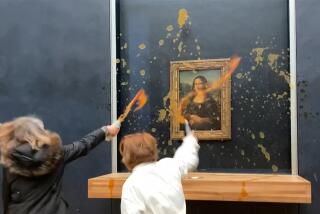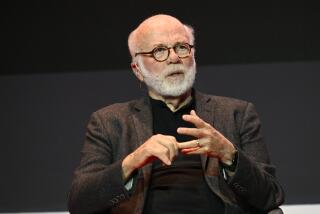COMMENTARY : Radice’s Save-the-NEA Policy an Act of Self-Immolation
- Share via
Pop quiz: What’s the difference between the cancellation of a controversial exhibition for fear of offending conservative members of Congress on the eve of federal budget hearings for the National Endowment for the Arts, as famously happened at Washington’s Corcoran Gallery of Art in 1989, and Tuesday’s cancellation of two exhibition grants by the NEA’s acting chairman, for fear of offending conservative voters on the eve of President Bush’s reelection campaign?
Time’s up, pencils down. If you answered “none,” you’re at least half-right. The two events do create a fearful symmetry.
Former Corcoran director Christina Orr-Cahall’s 1989 decision to cancel “The Perfect Moment,” an NEA-funded retrospective of the important photographer Robert Mapplethorpe, was certainly appalling. In its weak-kneed flight from a defense of art as something that could legitimately explore territory guaranteed to make many people squeamish--including people like myself, who nonetheless admire Mapplethorpe’s art--the cancellation spoke of a knuckleheaded perspective.
“Corcoranism,” as one critic aptly dubbed this intellectually insupportable point of view, is the doctrine that the preservation of art’s support systems justifies suppressing art itself. Corcoranism holds self-censorship aloft as a value, while branding as intolerable the spontaneous combustion of ideas that art can ignite. Corcoranism is vigorously pro-institution and quietly anti-art.
This lunatic save-the-NEA philosophy has now been brought inside the federal agency. Anne-Imelda Radice, who ascended to its acting chairmanship when John Frohnmayer was forced from the post several months ago, is a Corcoranist of the first rank. In recent congressional testimony that’s as remarkable for its brazenness as for its embrace of the self-immolating doctrine, Radice announced that she was prepared to go very far indeed to keep the NEA from “going down the tubes.”
How far? Well, as she went on to explain in hair-raising testimony, far enough to balance professional evaluations of artistic merit in NEA-funded programs with her own sense of Washington politicians’ likely reaction to them.
That the acting chairman meant what she said became clear Tuesday, when she unilaterally overturned recommendations for exhibition grants to MIT and to Virginia Commonwealth University. Both grant proposals include some art depicting nudes, and both had been supported by panels of professional peers and by the National Council on the Arts.
Surely it is in the nature of bureaucracies to perpetuate themselves, and even to fight for self-preservation with the ruthlessness of a cornered beast under mortal attack. For several years, the NEA has been the focus of an extraordinary barrage--principally from people who care not a whit for the arts, but who have recognized the agency as a useful weapon in their own struggle for power. Today they have an accomplice in Radice, who seems more than happy to regard the NEA as part of the arsenal of partisan politics.
That’s why you’d only be half-right in thinking there’s no difference between Radice’s grant cancellations at the NEA and Orr-Cahall’s exhibition cancellation at the Corcoran three years ago. For the magnitude of the first swamps the quaint grotesquerie of the second.
Radice’s is an act of censorship because it categorically bars a particular kind of art. Her rationale, uttered in an official statement issued by the NEA, is that neither MIT nor Virginia Commonwealth University demonstrated in their applications that the proposed exhibitions would measure up to the agency’s criterion of artistic excellence. But, who can believe that?
The disbelief stems from more than a recognition of the acting chairman’s own lack of demonstrated ability to render such a pious judgment. Like Frohnmayer before her--and, like chairman Frank Hodsoll before him--Radice has virtually no record as a distinguished figure in the visual arts.
After working for nearly a decade as a functionary in the office of the architect of the U.S. Capitol, she became the founding director of the National Museum of Women in the Arts, a new Washington institution that opened in 1985 with great fanfare--and to uniformly withering reviews. Since then, it has barely registered as a presence on the cultural landscape.
During Radice’s four-year tenure at the helm, not a single noteworthy exhibition emanated from her museum. Frankly, though, even if she were the reincarnation of Bernard Berenson, could anyone at this late date possibly believe that evaluations of artistic merit guide decisions in the chairman’s office at the NEA? How stupid do they think the public is?
Claiming fealty to “artistic merit” is now just a hollow cover for political diddling--for banishing threats to established authority without having to answer for your actions. Frohnmayer was axed because he couldn’t keep the NEA from being a liability in the reelection plans of George Bush, whose party has been hemorrhaging badly at the far right flank. Radice was maneuvered into place to stop the bleeding.
The exhibitions at MIT and Virginia Commonwealth University are casualties of the 1992 presidential campaign--nothing more, nothing less. It’s conventional wisdom that incumbent politicians have an edge because they come armed with all the institutional powers of government at their fingertips. Now, President Bush has demonstrated that artistic censorship can be prominently featured among them.
More to Read
The biggest entertainment stories
Get our big stories about Hollywood, film, television, music, arts, culture and more right in your inbox as soon as they publish.
You may occasionally receive promotional content from the Los Angeles Times.











